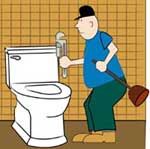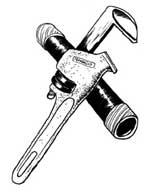Warm up Your Home by Installing Wainscoting
Wainscoting is a type of paneling used on the lower 3' to 4' of an interior wall. In earlier years its purpose was to cover the lower half of walls that were affected by cold and dampness but now it is mainly decorative. Traditionally it was made from mostly hard wood tongue and groove boards, but now ceramic tile and other wood products are also quite popular. It continues to provide richness and warmth to homes today just as it did in the past. There is a very wide range of style and price depending on what type of atmosphere you are looking for. Wainscoting is a very effective way to create character and personality in any room. A den could have a deep wine color to create a cozy feel or a child's room could be made to look cheerful by painting it a beautiful sunshine yellow. If you have a room that is used often, wainscoting is an excellent way to absorb and/or hide physical damage better than your average painted wall. It serves as a great cover up for holes, scratches and imperfections! It is also very easy to install. We used tongue and groove pine when we remodeled our bathroom a few years ago. We nailed tongue-and-groove boards vertically to the wall and finished off with a fancy piece that ran horizontally along the top. This top piece hides imperfections and can also serve as a chair rail. Manufacturers are now capable of making large panels thereby reducing the number of seams and virtually eliminating cracks, which have plagued traditional construction.
Installation Instructions
Tools required: - Hammer
- Chop saw, circular saw, or hand saw (for cutting boards to length if required)
- Jigsaw or hole saw (for cutting outlet holes)
- Table saw (to rip final pieces to the proper width)
- Pencil
- Level or laser level
- Chalk line (to snap guide lines)
- Measuring tape
- Utility knife (to trim mistakes!)
Installation tip before you begin: It is always a good idea to let any wood product acclimatize to your house for a few days when you get it. Wood products expand and contract with moisture and temperature, and wainscoting is no exception. - Carefully remove all baseboards, moldings, switch plates and outlet covers, and push furniture to one side.
- Locate and mark where the studs are in the wall. You will need this information when you put your top piece on.
- Decide how high you would like your wainscoting to come up the wall. You’ll need to mark a line across each wall you’re installing the wainscoting on. This can be accomplished a number of ways, each with it’s own advantages and disadvantages:
- Pick a corner to start. For tongue and groove pine you will need to 45 the side next to the corner so that your final piece will fit beside it properly. You can use either glue or nails to install your boards. If you are nailing, put one nail near the top, and another near the bottom so baseboard and trim (chair rail) will cover the nails.
Hint: Try not to nail where it can be seen. For instance, we nailed at an angle into the “tongue” so it would be covered by the “groove” of the next piece. If you do need to nail where it can be seen remember to go back and set the nail later! - Continue around the room working from left to right or right to left making sure that the tops are even with the level line you created. If one of the panels falls over an electrical outlet, you will need to measure where the panel hits the outlet and cut the panel to accommodate it. You may also need to set the outlet out to match the thickness of the boards.
- The horizontal piece (chair rail) and the baseboard are the last pieces to be attached. These two pieces will cover any uneven tops and cover up the nails.
Note: Keep in mind that your baseboard will cover any discrepancies at the bottom and the top/chair rail will cover any unevenness at the top. Be sure to take in to consideration the top piece when measuring how high you would like the wainscoting on your wall. Hint: When knotty pine wainscoting is being used be careful of the knots. Sometimes the knots fall out leaving holes in your beautiful finished wall. You can glue them back in if you can find them. If the dog chews them up…you are out of luck. We decided to not use the boards with large knots in them. - After completing the installation your new wainscoting can be painted, stained, or varnished to suit the desired look of your room.
Thanks for the wainscoting installation instructions. Take me back home.
|


